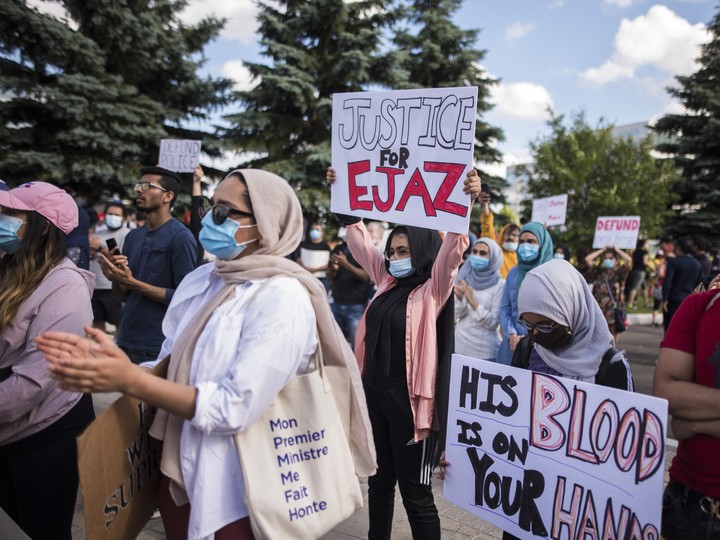powered by:
valneva canada inc.
justin ling: psychiatric teams, not the police, should be responding to mental-health calls
more than one-in-five interactions between rcmp officers and emotionally disturbed individuals ended in serious injury or death, 2014 study found
jun 30 2020
 4 minute read
4 minute read

we apologize, but this video has failed to load.
try refreshing your browser, or
tap here to see other videos from our team.
tap here to see other videos from our team.
by justin ling
calls to defund the police have grown louder in canada after a number of people in crisis were shot and killed by police officers conducting “wellness checks.”
those cases have underscored just how dangerous it can be to send armed officers to try to help someone having a mental-health episode. research prepared with the help of the royal canadian mounted police proves exactly that point.
a 2014 study shows more than one-in-five interactions between rcmp officers and individuals believed to be “emotionally disturbed” ended in serious injury or death of the person, twice the rate of interactions where officers had to deploy force on someone “not perceived to be emotionally disturbed.” officers were similarly twice as likely to be injured in those cases.
the research was conducted by carleton phd student simon baldwin — who is also an rcmp employee. he analyzed about 450 cases, between 2012 and 2013, where there were signs of excited delirium syndrome, a diagnosis that describes individuals who are facing a particularly acute mental-health episode.
baldwin relied on the rcmp’s subject behaviour/officer response database, which tracks every time an officer deploys force in the line of duty. until very recently, the force refused to release numbers from the database, and this research appears to be the only academic paper relying on it, making it a rare statistical look into rcmp practices.
advertisement
advertisement
the study is a clear sign that the status quo isn’t just dangerous, it’s often ineffective.
baldwin found that when someone showed signs of excited delirium syndrome, force was ineffective about 40 per cent of the time, compared with just 13 per cent when those signs weren’t present.

“all intervention options are less effective on subjects perceived to be emotionally disturbed,” the report found.
excited delirium syndrome is hard to diagnose, and its signs overlap significantly with other types of mental-health episodes. but gary vilke, professor of clinical emergency medicine at the university of san diego, says he has seen numerous cases in the er. from the research available, the syndrome can be brought on by a number of factors, including recreational drug use or abruptly ceasing medication for a psychiatric condition. someone experiencing excited delirium syndrome can experience hallucinations, paranoid delusions, aggressive behaviour, rapid breathing, high pain tolerance and a lack of physical exhaustion.
vilke links it to revving an engine. “normally things that would put our brakes on … sort of get blocked by this process,” he says, adding that getting these individuals sedated and treated can be crucial to their well-being, as a prolonged episode can cause cardiac arrest.
advertisement
advertisement
yet baldwin’s study clearly shows that the rcmp’s model is not effective when dealing with someone in this state. and while officers are trained to de-escalate a situation before force is deployed, once force is issued, they often find themselves ill-equipped to explore alternatives.
“i was truly afraid that with all the intervention models i had, nothing was working,” one officer wrote in their occurrence report, which was included in baldwin’s report. “i did not know what else to do.”
vilke acknowledges that police may need to deploy force, especially tasers, in order to get them restrained. “there is no perfect right answer,” he says, adding: “the best thing you can do with these people is limit their physical confrontation.”
as public safety minister bill blair told the national post earlier in june, “the rcmp use of force model became the model for all police services in the country.”
that model instructs officers to use more aggressive and potentially deadly force only when an individual actively resists or poses a threat to themselves, others, or the officer. while the model calls on officers to observe the “emotional state” of an individual, and to perceive “emotional venting” as a sign of possible threat, it does not mention excited delirium syndrome or mental health. the model was last updated in 2009.

advertisement
advertisement
this model is fundamentally at odds with what is being asked in these circumstances. when families called police in mississauga, ont., and edmundston, n.b., recently, they wanted psychiatric help for their loved one. after police responded however, the confrontations escalated and officers shot and killed both individuals. in another case, in kelowna, b.c., an rcmp officer can be seen on video dragging a nursing student and standing on her neck after finding her semi-conscious in her bathroom.
by sending armed officers to conduct these “wellness checks,” there is a missed opportunity for de-escalation. as baldwin notes “some officers seem to be acutely aware of how their appearance as a police officer may be interpreted as a threat by these subjects in crisis.”
rcmp officers, who provide local policing in many parts of the country, respond to about 2.7 million calls a year. statistics canada reports that the majority of calls to police in canada are not criminal in nature.
because the rcmp does not proactively release information from its internal database, the numbers in baldwin’s report are the most recent snapshot regarding mental health. the internal rcmp database does not include data on race or indigenous status.
advertisement
advertisement
the data we do have, however, shows that the current model is untenable. while police may be needed in some, or even most, cases, there is a desperate need for dedicated psychiatric response teams who are trained to handle more difficult situations of people in crisis. only when they fail should police engage.
change needs to happen. the status quo is getting people killed.




